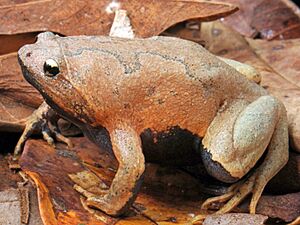Stereocyclops incrassatus facts for kids
Quick facts for kids Stereocyclops incrassatus |
|
|---|---|
 |
|
| Conservation status | |
| Scientific classification | |
| Synonyms | |
|
Emydops hypomelas Miranda-Ribeiro, 1920 |
The Brazilian dumpy frog (Stereocyclops incrassatus) is a type of frog. It belongs to the Microhylidae family. This frog lives only in eastern Brazil. You can find it in states like Pernambuco, Alagoas, Bahia, Minas Gerais, and Espírito Santo. Some frogs once thought to be this species in São Paulo are now known to be a different kind, Stereocyclops parkeri.
What Does It Look Like?
This frog has a very stout or chunky body. An adult male frog is usually about 41 millimeters (1.6 inches) long. Other adult frogs, both males and females, can be between 37 and 46 millimeters (1.5 to 1.8 inches) long.
Its snout, which is its nose area, is short and rounded. The frog has small eyes. Its tympanum, which is like an eardrum, is hard to see. The fingers on its front feet are quite long and do not have any webbing between them. Its toes are also long, but they have a little bit of webbing at their base. The frog's skin is smooth, but it might have a few small bumps on its sides.
Where Does It Live and What Does It Eat?
The Brazilian dumpy frog lives in habitats like primary and secondary forests. These are forests that have either been untouched or have grown back after being disturbed. They live in areas below 550 meters (1,800 feet) in elevation.
This frog is a nocturnal creature, meaning it is active at night. It spends its time living in the leaf litter on the forest floor. These frogs eat a variety of small invertebrates, which are animals without backbones. Their favorite foods include ants, beetles, and small crustaceans called isopods.
Reproduction and Conservation
Brazilian dumpy frogs breed in small, temporary ponds found inside the forest. They do not breed in open areas outside the forest. When they breed, many frogs gather together at once.
This species can be very common in places where it breeds. However, a big threat to these frogs is habitat loss. This happens when their forest homes are destroyed. Luckily, the Brazilian dumpy frog lives in several protected areas, like Rio Doce State Park. These parks help keep their homes safe.


